Pseudomonas Genome Database: facilitating user-friendly, comprehensive comparisons of microbial genomes
- PMID: 18978025
- PMCID: PMC2686508
- DOI: 10.1093/nar/gkn861
Pseudomonas Genome Database: facilitating user-friendly, comprehensive comparisons of microbial genomes
Abstract
Pseudomonas aeruginosa is a well-studied opportunistic pathogen that is particularly known for its intrinsic antimicrobial resistance, diverse metabolic capacity, and its ability to cause life threatening infections in cystic fibrosis patients. The Pseudomonas Genome Database (http://www.pseudomonas.com) was originally developed as a resource for peer-reviewed, continually updated annotation for the Pseudomonas aeruginosa PAO1 reference strain genome. In order to facilitate cross-strain and cross-species genome comparisons with other Pseudomonas species of importance, we have now expanded the database capabilities to include all Pseudomonas species, and have developed or incorporated methods to facilitate high quality comparative genomics. The database contains robust assessment of orthologs, a novel ortholog clustering method, and incorporates five views of the data at the sequence and annotation levels (Gbrowse, Mauve and custom views) to facilitate genome comparisons. A choice of simple and more flexible user-friendly Boolean search features allows researchers to search and compare annotations or sequences within or between genomes. Other features include more accurate protein subcellular localization predictions and a user-friendly, Boolean searchable log file of updates for the reference strain PAO1. This database aims to continue to provide a high quality, annotated genome resource for the research community and is available under an open source license.
Figures

References
-
- Stover CK, Pham XQ, Erwin AL, Mizoguchi SD, Warrener P, Hickey MJ, Brinkman FS, Hufnagle WO, Kowalik DJ, Lagrou M, et al. Complete genome sequence of Pseudomonas aeruginosa PA01, an opportunistic pathogen. Nature. 2000;406:959–964. - PubMed
-
- Brinkman FS, Hancock RE, Stover CK. Sequencing solution: Use volunteer annotators organized via internet. Nature. 2000;406:933. - PubMed
Publication types
MeSH terms
Substances
LinkOut - more resources
Full Text Sources
Other Literature Sources
Molecular Biology Databases

